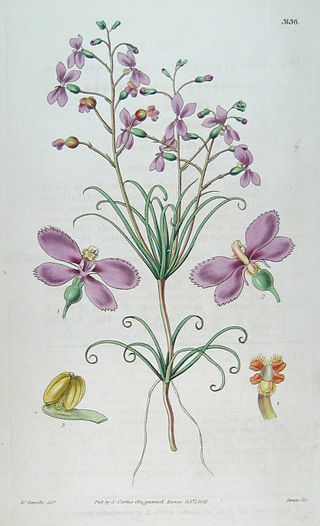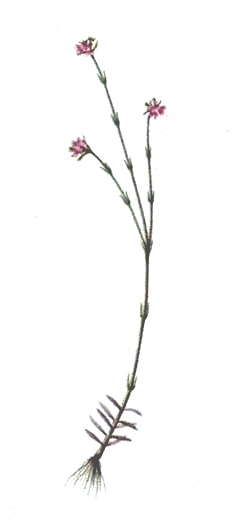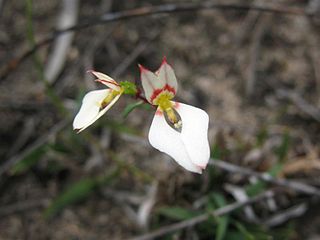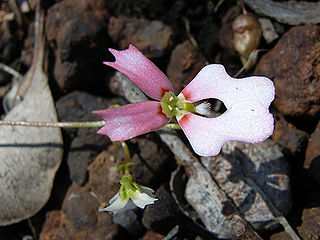
Stylidium is a genus of dicotyledonous plants that belong to the family Stylidiaceae. The genus name Stylidium is derived from the Greek στύλος or stylos, which refers to the distinctive reproductive structure that its flowers possess. Pollination is achieved through the use of the sensitive "trigger", which comprises the male and female reproductive organs fused into a floral column that snaps forward quickly in response to touch, harmlessly covering the insect in pollen. Most of the approximately 300 species are only found in Australia, making it the fifth largest genus in that country. Triggerplants are considered to be protocarnivorous or carnivorous because the glandular trichomes that cover the scape and flower can trap, kill, and digest small insects with protease enzymes produced by the plant. Recent research has raised questions as to the status of protocarnivory within Stylidium.

The family Stylidiaceae is a taxon of dicotyledonous flowering plants. It consists of five genera with over 240 species, most of which are endemic to Australia and New Zealand. Members of Stylidiaceae are typically grass-like herbs or small shrubs and can be perennials or annuals. Most species are free standing or self-supporting, though a few can be climbing or scrambling.

Stylidium repens, the matted triggerplant, is a dicotyledonous plant that belongs to the genus Stylidium. S. repens is endemic to Australia and is found primarily in southwest Western Australia. This species is a creeping or scrambling triggerplant, which can spread over large areas as a tangled mat of stems and aerial roots. The older stems are grey whereas younger stems appear red and have terminal rosettes of small leaves, five mm to one cm in length. When the rains come, new roots and a one to three flowers emerge from the terminal rosettes. This is the only species of triggerplant known to regularly flower twice a year—in autumn and late spring. Pollination, which is typically very specialized in this genus, is achieved with a variety of insects in this species.

Stylidium graminifolium, the grass triggerplant, is a dicotyledonous plant that belongs to the genus Stylidium. This species used to belong to the Stylidium graminifolium complex, but the name was conserved for this single species when two others were split from the complex and introduced as new species in 2001. S. graminifolium is endemic to Australia and is the Stylidium species with the widest distribution throughout Australia. It is a perennial plant with grass-like leaves and is easily cultivated. It has been considered to be a carnivorous or protocarnivorous plant because it possesses glandular trichomes underneath the flowers that can trap and digest prey.

Tolypangium is a subgenus of the genus Stylidium that is characterized by ovoid to longish capsules. This subgenus was part of the earliest taxonomic division among the triggerplants. Stephan Ladislaus Endlicher first split the genus into two subgenera in 1838: Tolypangium with its ovoid capsules and Nitrangium with its linear capsules. Subsequent authors generally followed this classification, which is based almost entirely on the features of the capsule. Recent genetic analysis, combined with an exhaustive morphological comparison, has revealed that the classification defined by Johannes Mildbraed in 1908 is not the most accurate description of how the members of different subgenera and sections are related. As part of the Flora of Australia series, Juliet Wege will be reviewing and updating the taxonomy of the Stylidiaceae.

Verticillatae is a section in the subgenus Tolypangium that is characterized by globose capsules. Recent genetic analysis, combined with an exhaustive morphological comparison, has revealed that the classification defined by Johannes Mildbraed in 1908 is not the most accurate description of how the members of different subgenera and sections are related. As part of the Flora of Australia series, Juliet Wege will be reviewing and updating the taxonomy of the Stylidiaceae.

Stylidium section Tenella is a taxonomic rank in the plant kingdom under Stylidium subgenus Andersonia. In 2000, A.R. Bean published a taxonomic revision of subgenus Andersonia and established this section to separate these eleven species based on morphological and cladistic analysis. This taxonomic rank is named after George Bentham's series Tenellae, which he established in his 1869 treatment of the family Stylidiaceae. Series Tenellae was not used in Johannes Mildbraed's 1908 taxonomic monograph in which he completely revised the subgeneric taxonomy of the genus. Mildbraed's treatment of the genus taxonomy is the general demarcation which has been used in subsequent revisions and additions.
Stylidium tenerrimum is a dicotyledonous plant that belongs to the genus Stylidium. It is an erect annual plant that grows from 4 to 30 cm tall. Linear, oblanceolate, or deltate leaves, about 5-24 per plant, are scattered along the stems. The leaves are generally 1.2-4.8 mm long and 0.3-0.8 mm wide. This species lacks a scape but has cymose inflorescences that are 4–11 cm long. Flowers are white and red. S. tenerrimum is found around Darwin in the Northern Territory of Australia and the Victoria River, though it hasn't been recollected there since the type location was chosen. Its typical habitat is sandy soils that remain moist, associated with grasses and sedges. It flowers in the southern hemisphere from April to August. S. tenerrimum is most closely related to S. alsinoides, though it differs by its asymmetrical petals. In his revision of the subgenus Andersonia in 2000, A.R. Bean placed S. evolutum into synonymy and noted that the type specimen of S. mitrasacmoides was not located and thus the application of this synonym is not certain. Tony Bean assessed this species' conservation status as data deficient in 2000.
Stylidium ensatum is a dicotyledonous plant that belongs to the genus Stylidium that was described as a new species by A.R. Bean in 2000, though the taxon had been noted by Rica Erickson in her discussion of S. muscicola variation in 1958. The specific epithet ensatum is from the Latin ensatus, meaning sword-like, which refers to the shape of the floral throat appendages of this species. It is an erect annual plant that grows from 14 to 22 cm tall. Obovate or orbicular leaves, about 6-17 per plant, are scattered along the stems. The leaves are generally 7–12 mm long, 5.5–12 mm wide, and lack petioles. This species generally has one to three scapes and cymose inflorescences that are 8–16 cm long. Flowers are pink or mauve. S. ensatum is endemic to the area around Darwin in the Northern Territory of Australia. Its habitat has been reported as being a "Melaleuca viridiflora-Lophostemon lactifluus forest with damp peaty soil." It flowers in the southern hemisphere from June to July. S. ensatum is most closely related to S. muscicola. Its conservation status has been assessed as data deficient.
Stylidium schizanthum is a dicotyledonous plant that belongs to the genus Stylidium that was described by Ferdinand von Mueller in 1859. It is an erect annual plant that grows from 9 to 30 cm tall. Obovate, orbicular, or oblanceolate leaves, about 3-13 per plant, form basal rosettes. The leaves are generally 3.5–23 mm long and 1.5–12 mm wide. This species generally has one to four scapes and cymose inflorescences that are 9–30 cm long. Flowers are white, pink, mauve, or yellow. S. scizanthum's distribution ranges from the Kimberley region in Western Australia through the Northern Territory and into northern Queensland. It has been reported as far south as Mount Surprise and even in southern New Guinea. Its typical habitats are moist sand in Eucalyptus or Melaleuca communities, near creekbanks, or associated with sandstone landscapes. It flowers in the southern hemisphere from February to October. S. schizanthum is closely related to both S. pachyrrhizum and S. lobuliflorum.
Stylidium nominatum is a dicotyledonous plant that belongs to the genus Stylidium. It is an annual plant that grows from 4 to 15 cm tall. The oblanceolate leaves, about 5-15 per plant, form basal rosettes around the stem and are 2.5–9 mm long, 0.5-1.5 mm wide. About 4-11 leaves per plant are also scattered along the stem and are generally 2.3-4.7 mm long and 0.3-0.5 mm wide. Scapes are absent. Inflorescences are 2–6 cm long and produce white flowers that bloom from April to June in the southern hemisphere. S. nominatum is endemic to the northern area of Kakadu National Park and Melville Island in the Northern Territory. Its habitat is recorded as being sandy soils in Melaleuca viridiflora woodlands, bases of sandstone escarpments, and gravelly yellow soil in flat, treeless areas. S. nominatum is most closely related to S. capillare. In his recent revision of the subgenus Andersonia, Anthony Bean (A.R.Bean) noted that there is a large variation recorded in the specimens of this species and more work would need to be done to determine if there's more than one taxon involved with this species. Further evaluation may reveal additional species.
Stylidium trichopodum is a dicotyledonous plant that belongs to the genus Stylidium. It is an annual plant that grows from 6 to 20 cm tall. The linear leaves, about 20-200 per plant, are scattered along the elongate, glabrous stems. The leaves are generally 3–9 mm long and 0.2-0.7 mm wide. Petioles are absent. This species produces 1-10 scapes per plant. Inflorescences are 2.6–6 cm long and produce a single yellow or orange flower that blooms in June and July in the southern hemisphere. S. trichopodum is endemic to northern Queensland and is only known from a few populations. Its habitat is recorded as being moist sandy soils on flat or gently sloping terrain, sometimes in areas dominated by Melaleuca species. S. trichopodum is most closely related to S. pedunculatum, though it differs by its much larger flower and its cauline leaves instead of terminal rosettes for S. pedunculatum.

Levenhookia, also known as the styleworts, is a genus of ten recognized species in the family Stylidiaceae and is endemic to Australia. The genus is restricted to Western Australia almost exclusively with a few exceptions: L. pusilla's range extends into South Australia, L. dubia's range extends through South Australia into Victoria and New South Wales, L. sonderi is native only to Victoria, and L. chippendalei is also found in the Northern Territory.

Stylidium calcaratum, the book triggerplant, is a dicotyledonous plant that belongs to the genus Stylidium. It is an ephemeral annual that grows from 5 to 10 cm tall but can grow larger at 20–30 cm tall in damp forest or scrub habitat. The few ovate leaves produced by this plant form basal rosettes around the stem. The leaves are around 3–5 mm long on short petioles. The scapes are 2–30 cm tall and produce single flowers in smaller plants and up to nine flowers in larger, more robust plants. Flowers are pink or white with red spots or lines at the individual petal bases. The petals are vertically paired and will fold over to meet each other at night or in adverse weather conditions. S. calcaratum is endemic to Australia and has a distribution that ranges from Victoria through South Australia and into Western Australia. Its habitat is recorded as being wet flats or near creeks and seepages. Pollination is achieved by a grey fly, Comptosia cuneata.

Stylidium ecorne is a dicotyledonous plant that belongs to the genus Stylidium. It is an annual plant that grows from 5 to 12 cm tall. It has pale or bright pink flowers and occurs in swampy areas.
Stylidium leptorrhizum is a dicotyledonous plant that belongs to the genus Stylidium. It is an herbaceous annual plant that grows from 8 to 25 cm tall. Oblanceolate or elliptical leaves, about 10-20 per plant, form a basal rosette with stems absent. The leaves are generally 14–60 mm long and 3–9.5 mm wide. This species produces 1-3 scapes per plant. Inflorescences are 8–25 cm long and produce pink or mauve flowers that bloom from May to August in their native range. S. leptorrhizum is endemic to the Kimberley region of Western Australia and the Victoria River district of the Northern Territory. Its typical habitat has been reported as sandy soils along creeks or billabongs. S. leptorrhizum is most closely related to S. multiscapum. When reviewing section Debilia, Anthony Bean reduced the recently described S. barrettorum to synonymy with S. leptorrhizum after examining the type specimen.

Forstera is a genus of small perennial plants in the Stylidiaceae family named in honour of the German naturalists Johann Reinhold Forster and his son, Georg Forster, who had previously described Forstera's sister genus, Phyllachne just five years earlier. It comprises five species that are endemic to New Zealand with the exception of F. bellidifolia, which is endemic to Tasmania. The species in this genus resemble those in a subgenus of the related genus Stylidium called Forsteropsis, but they are more closely related to the genus Phyllachne. Proposals to merge the two genera based on information from cladistic analysis have emerged because of these genera's morphological similarities and evidence that they are paraphyletic.

Forstera bellidifolia, the Tasmanian forstera, is a species in the family Stylidiaceae that is endemic to Tasmania, Australia. It was described by William Jackson Hooker in an 1851 volume of Icones Plantarum. It is notably different from other members of the genus in that it is not native to New Zealand nor does it possess the epigynous nectaries that are present in the other species.

Stylidium armeria, the thrift-leaved triggerplant, is a species of Stylidium that is native to Australia. It is an herbaceous perennial that grows from 50 to 100 cm tall. Narrowly lanceolate to narrowly oblanceolate leaves, about 15–40 mm long, are tufted at the base and are erect to spreading. Inflorescences produce 25–100 dark pink-magenta flowers that bloom August to February in its native range.

Stylidium affine is a species in the genus Stylidium that is endemic to Western Australia.














